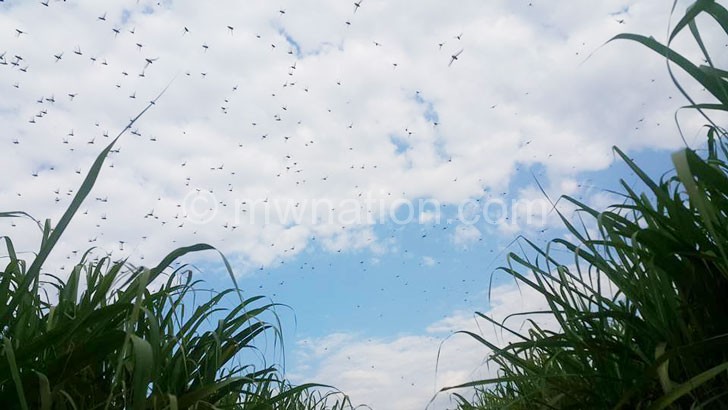2016: Locusts worsened food shortage in Shire valley
The saying that it never rains but pours felt so real for people of Shire Valley, especially in Nsanje, when locusts invaded the district, destroying 30 hectares of maize within 14 days.
This happened when people of the district—one of the areas badly hit by the food shortage that the country is currently experiencing—hoped winter cropping would rescue them.
After two weeks of causing havoc, the locusts, identified as African migratory locusts, crossed to Nchalo in Chikwawa where they devoured 405 hectares of sugar cane belonging to Illovo Sugar (Malawi) Limited at the firm’s Nchalo Estate.
Illovo Sugar Malawi spokesperson Irene Phalula and Shire Valley Agriculture Development Division (ADD) principal crop protection officer Ringstone Taibu confirmed the news in separate interviews on August 9 2016.

Illovo Sugar Malawi said it spent about K8 million to fight the locusts.
The genesis of the locusts’ outbreak
Nsanje district commissioner (DC) Gift Rapozo confirmed that the locusts first appeared on July 22 2016 for only 10 minutes and then disappeared, only to reappear, destroying five hectares of maize crop in the process.
He said the locusts seemed to have been breeding in neighbouring Mozambique, making it hard for Malawian authorities to trace and spray the breeding areas.
Commenting on the issue, Taibu did not play down the impact of the attack, saying the locusts posed serious threats because they could cover a large area within a short time.
He said: “In some areas, the swarm was intercepted before landing. People had to shout, throw sand in the air and use tree branches. Our plan is not to destroy the insects, but to deal with the breeding grounds.”
However, Taibu said the success of this formula was dependent on Mozambique, the source of the locusts. He indicated that Malawi was waiting for the intervention of the International Red Locust Control Organisation for Central and Southern Africa (Irlcosca) which had been to Tanzania fighting similar pests.
Outbreak forces government, Illovo Malawi to meet
Following warnings from experts that the outbreak had the potential to go beyond Nsanje, Ministry of Agriculture, Irrigation and Water Development met officials of Illovo Malawi during the first week of August.
The discussion centred on how to deal with the locusts as government had contracted Illovo’s Nchalo Estate to grow maize under irrigation to minimise food shortage following the drought registered during the previous growing season.
Soon after the meeting, locusts crossed over to Chikwawa where they destroyed 405 hectares of sugar cane belonging to Illovo Malawi despite the company’s officials saying in earlier interviews that they were prepared to stop the locusts from attacking their fields.
Phalula said the swarm arrived at the estate on August 8 and landed on 120 hectares of sugar cane field before blanketing 405 hectares of mature sugar cane plantations. She, however, said the damage would not affect yield.
To prevent the swarm from destroying the crops during the night, an aerial spray of cypermethein was commissioned immediately supported by individual sprays on the ground throughout the night. However, experts noted that cypermethein did not kill the insects, but instead produced smell that scared the pests.
Phalula admitted that the measure was temporary, saying that the preferred chemical that kills locust is Fenetrothion which Illovo Malawi did not have in stock.
“Instead, yesterday morning we sprayed Fipronil, but it is not effective because it kills locusts after 48 hours. Currently, the locusts are in the fields, but weak,” she said.
Locusts finally killed
On August 10 2016, Illovo Malawi declared victory over the insects after the pests died 24 hours after the company sprayed Fipronil. This was before the swarm hit the maize fields under winter cropping, a situation that brought a sigh of relief to government because if the maize had been attacked its plans to lessen hunger might have been compromised.
Following the development, Illovo Malawi partnered Shire Valley ADD in sensitisation campaigns in communities covered by the division to stop people from selling, buying and eating the locusts killed by the chemicals.
In the course of all this, the Ministry of Agriculture, Irrigation and Water Development said they had deployed technical staff from Lilongwe to work with Shire Valley ADD to do spot spraying using motorised sprayers which the division already had.
Way forward
Experts explained that the solution to eradicating locusts—which are one of the causes of famine and starvation around the world—is to deal with the source, in this case, Mozambique. Considering that doing so required the intervention of Irlocsa which covers Malawi, Mozambique, Zimbabwe, Zambia, Tanzania and Uganda, one can only hope that government made required efforts for the team to be here. If not, we all know the story we will be retelling this year. n





